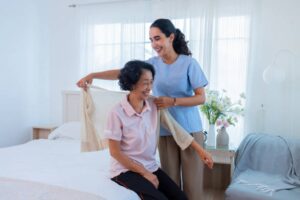Preparing Your Home for Elderly Care: A Comprehensive Guide
Preparing Your Home for Elderly Care: A Comprehensive Guide
Caring for an elderly loved one at home is a responsibility that demands both dedication and careful planning. It’s a transition that involves preparing your living space to ensure it is safe, comfortable, and capable of meeting the unique needs of seniors. As families increasingly opt for in-home care arrangements, understanding the essentials of this preparation can make a significant difference in the quality of life for both the caregiver and the recipient. Whether you’re aiming to accommodate the needs of a relative or setting up your home to welcome professional aides, this comprehensive guide will walk you through the crucial steps involved in preparing your home for elderly care.
Understanding the Needs of the Elderly
The first step in preparing a home for elder care involves gaining a genuine understanding of the unique challenges and needs that arise with age. As we age, the likelihood of experiencing mobility issues, balance difficulties, and chronic health conditions increases. Recognizing these factors can help you tailor your home environment to better suit the person in your care.
Physical constraints such as arthritis, weakening bones, or conditions like Parkinson’s Disease might necessitate installations such as grab bars or additional seating. Sensory impairments, including vision or hearing loss, can also impact the ease of daily activities. Therefore, by prioritizing an understanding of these individualized needs, you can create a space that not only maximizes accessibility but also enhances the dignity and independence of your loved one.
Safety First: Addressing Physical Hazards
Ensuring the safety of your home is paramount when caring for an elderly family member. Falling is a significant risk for older adults, and even minor accidents can lead to serious injuries or complications. Start by examining high-traffic areas in the home, such as the living room, kitchen, and bathrooms, for potential trip hazards. Remove loose rugs, tuck away electrical cords, and ensure that all pathways are clear and well-lit.
In the bathroom, install sturdy grab bars near the toilet and in the shower to provide support. Non-slip mats can help prevent slips and falls on wet surfaces. Similarly, consider the installation of a walk-in shower to reduce the risks associated with stepping over a bathtub edge. Additionally, adjust the water heater’s thermostat to prevent burns from excessively hot water.
For individuals with diminished vision, improving lighting can prevent accidents. Use nightlights in hallways and areas leading to the bathroom to guide them safely at night. Moreover, eliminating clutter can make a significant difference in reducing fall risk and improving overall safety.
Creating a Comfortable Living Environment
Beyond safety, comfort is another crucial aspect of preparing your home for elderly care. A comfortable environment can greatly enhance mental well-being and reduce stress for your loved one. Consider the placement of furniture to ensure it accommodates any mobility aids necessary, such as walkers or wheelchairs. Arrange seating to be easily accessible and at an appropriate height to help with ease of sitting and standing.
Temperature regulation is also important; older adults are often more sensitive to temperature extremes. Ensure that the heating and cooling systems in the home are efficient and that your loved one has access to additional blankets or fans as needed. Providing the means to control these can also empower them to adjust their environment to their liking.
Moreover, maintaining a soothing aesthetic contributes to a homey atmosphere. Keep cherished photographs, favorite books, or mementos within reach to provide comfort and familiarity. These personal touches not only make a space feel inviting but also play a vital role in keeping their spirit uplifted.
Facilitating Easy Mobility
Mobility is key to independence, and therefore, homes should be configured to promote ease of movement. Start by evaluating the home’s accessibility from the outside. Ensure that the approach to the house, including walkways and steps, are in good condition and consider adding a ramp if steps are a barrier.
Inside the home, focus on the practicality of moving between rooms. Wider doorways can accommodate wheelchairs, and stairlifts might be necessary in multi-story residences. Ensure that essential rooms such as the bedroom, bathroom, and kitchen are easily reachable and arranged to minimize the need for rearrangement or excessive movement.
In addition, installing lever-style door handles and faucet fixtures can make them easier to use for individuals with limited hand strength. Ensuring that frequently used items are stored within reach, and not placed on high shelves, helps in fostering autonomy and reducing frustration.
Utilizing Home Care Services for Extra Support
Sometimes, even the most well-prepared home environment may require the assistance of professional caregivers. For families in Allentown, PA, and beyond, there’s a range of home care services in Allentown, PA available to provide skilled assistance and companionship for elderly members. These services can be tailored to varying levels of need, from part-time help with household chores to full-time medical support.
Engaging compassionate caregivers can also ease some of the stress on family members, providing them with peace of mind knowing their loved ones are in capable hands. Empowering your loved one with choices in their care aids in maintaining their dignity and self-esteem, while also allowing family members to participate in planning to ensure preferences and needs are well met.
Maintaining Social Connections and Activities
Social engagement is an often-overlooked yet critical component of elderly care. Interaction with family, friends, and community can greatly improve mental health and provide emotional support. Encourage regular visits from family members and engage with community resources that cater to seniors, such as senior centers or local clubs, where they can participate in activities suited to their interests and abilities.
Consider the use of technology to help maintain these connections. Simple devices, such as tablets with video calling capabilities, can enable your loved one to stay in touch with distant friends and relatives. Additionally, setting up digital photo frames or streamed entertainment services can offer enjoyment and encourage interaction.
Keeping your loved one active, both mentally and physically, not only aides in cognitive maintenance but also promotes a sense of independence and purpose. Always ensure activities are adaptable to their physical condition and that they feel comfortable and excited to participate.
Exploring Your Options in Professional Elderly Care
If you’re located around Harrisburg or Pittsburgh, forging connections with compassionate home care providers who service these areas can be immensely beneficial. They provide vital support, offering services that bridge the gap between home modifications and professional medical care. For those pondering more substantial care arrangements, it’s important to explore your options to determine the best fit for your family and beloved elder.
By working collaboratively with these providers, you can create an informed strategy that considers long-term needs while making sure that your loved one remains safe, engaged, and cared for. Each choice—from minor home adjustments to professional engagement—represents an investment in improving the wellbeing and quality of life for those you cherish the most.
Adapting and Continuing Care Strategies Over Time
Another important aspect of caring for an elderly loved one at home is the ongoing evaluation and adaptation of care strategies. Needs can change over time due to evolving health conditions or mobility capabilities. Regularly assessing the home environment and modifying as necessary to meet new requirements is crucial.
Maintain open lines of communication with the elderly individual to be responsive to their needs and concerns. Encourage them to voice any discomforts or difficulties they may encounter with the existing arrangement. Being proactive can not only preempt potential safety issues but also reassure them that their wellbeing is your primary concern.
Moreover, embrace the idea that it’s okay to seek external advice or help when required. Consulting with healthcare professionals, attending family caregiving workshops, or networking with others in similar situations can provide valuable insights and fresh perspectives. The collective experiences shared can impart practical solutions and provide a supportive community aiding both you and your loved ones through this journey.
In conclusion, preparing your home for elderly care requires thoughtful planning, empathy, and often, collaboration with professionals. By creating a safe and welcoming environment and tapping into comprehensive care resources, you pave the way for a nurturing and supportive atmosphere that honors your loved one’s needs and enhances their quality of life.





